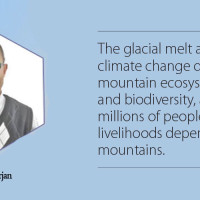- Tuesday, 1 April 2025
Contain Health Hazards Of Microplastics
Plastic has become an indispensable part of our daily lives. It has been used in various products that include but are not limited to consumer goods, packaging, textiles, and industrial settings. The issues of microplastics are less known but extremely concerning as we are relying heavily on plastic products. In recent years, microplastics have become an environmental and public health concern. These microscopic plastic particles, which are less than 5 millimeters in size, are now ubiquitously present from mountaintops to the ocean's depths and, unfortunately, even inside human bodies.
With research revealing their presence in human blood, lungs, breast milk, and even placental tissue, the health risks posed by microplastics can no longer be ignored. What began as a byproduct of convenience has silently turned into a global threat to ecosystems, wildlife, and human health. Microplastics, once dismissed as negligible, are now being recognised as one of the most insidious pollutants of our time.
Sources
It is essential to understand where microplastics come from and how they enter our bodies before discussing preventive measures. Seafood, salt, honey, bottled water, and even fruits and vegetables have been shown to contain microplastics, making them common sources. Dust, furniture, and clothing all contain synthetic fibers that add to the airborne microplastics we breathe in every day. Microbeads are found in some toothpastes, exfoliants, and cosmetics. Plastic containers and food wraps can release particles into the contents they hold when heated. We can start constructing a defense against the health hazards associated with microplastics by focusing on these exposure pathways.
Preliminary data indicates that microplastics can lead to cell damage, oxidative stress, and inflammation when we are exposed to them. The widespread presence of microplastics in everyday life through synthetic clothing, food packaging, cosmetics, and personal care products makes exposure nearly impossible to avoid. Minimising the use of plastic in daily life is one of the most straightforward ways to reduce microplastic exposure. Avoid single-use plastic bags, straws, bottles, and packaging. Always search for sustainable alternatives such as stainless steel bottles, glass containers, cloth bags, and paper wraps.
Studies have shown that bottled water often contains more microplastics than tap water. Use a high-quality home filtration system, preferably one that uses reverse osmosis or carbon block filters in order to reduce microplastics and other contaminants. It is suggested to avoid boiling water in plastic containers as heat releases microplastic faster. Moreover, washing synthetic textiles such as polyester, nylon, and acrylic release microfibers that can be swallowed or inhaled. Therefore, it is recommended to wear clothing composed of natural materials such as linen, cotton, or wool. Similarly, to prevent shedding fibers from entering the wastewater system, use a laundry bag or filter designed to catch microfibers while washing synthetic clothing.
One of the main sources of airborne microplastics is indoor dust. The amount of microplastic particles in the air we breathe can be decreased by utilising air purifiers, vacuuming frequently, and maintaining well-ventilated spaces. It is important to note that toothpaste, exfoliants, and cosmetics that include plastic-based chemicals or microbeads should be avoided. Because they come into contact with plastic during processing and storage, packaged and processed foods are more likely to contain microplastics. Therefore, select minimally processed, non-plastic-wrapped fresh meats, cereals, and fruit. When storing food, especially hot items, use glass or stainless-steel containers.
Governments must impose laws that restrict the manufacture of plastics and outlaw their hazardous applications. Prohibitions against single-use plastics, unnecessary packaging, and microbeads in cosmetics are good first measures. Enhancing recycling infrastructure, lowering industrial plastic leakage, and encouraging biodegradable substitutes should also be the main objectives of national policies. National policies should also focus on improving recycling systems, reducing industrial plastic leakage, and promoting biodegradable alternatives.
Current wastewater treatment plants are not equipped to filter out all microplastics. Upgrading these systems with advanced filtration technologies, such as membrane bioreactors and electrocoagulation methods, can significantly reduce the number of microplastics entering water bodies and, eventually, our food and drinking water supplies. Industries must take responsibility for the life cycle of the plastic products they produce. Companies should be become more responsible for gathering, recycling, or properly disposing of plastic garbage through the implementation of Extended Producer Responsibility (EPR) regulations. Similarly, it warrants investments in innovation in sustainable materials and environmentally friendly packaging.
Monitoring
However, effects of microplastics on human health, how they flow across ecosystems, and the most effective ways to lessen their effects, more study is required. In order to monitor microplastic pollution and their effects on health, governments and organisations must fund scientific research, public monitoring initiatives, and international databases. A widespread public health campaign can increase knowledge of the causes and risks of microplastics, which will motivate more individuals to take precautions. NGOs, community organisations, and schools can all be extremely helpful in educating people about environmental responsibility and sustainable living.
Furthermore, knowledgeable consumers are more likely to choose products and brands that put sustainability and transparency first. People can affect market trends and promote significant change by directing consumer demand toward companies that practice environmental responsibility. Though invisible to the naked eye, their impact is deeply felt from the depths of the oceans to the cells of our bodies. The hazards they pose to the environment and human health are no longer theoretical; they are real, immediate, and intensifying.
(Dr. Lohani is the executive director at the health concern. lohanis@gmail.com)

















